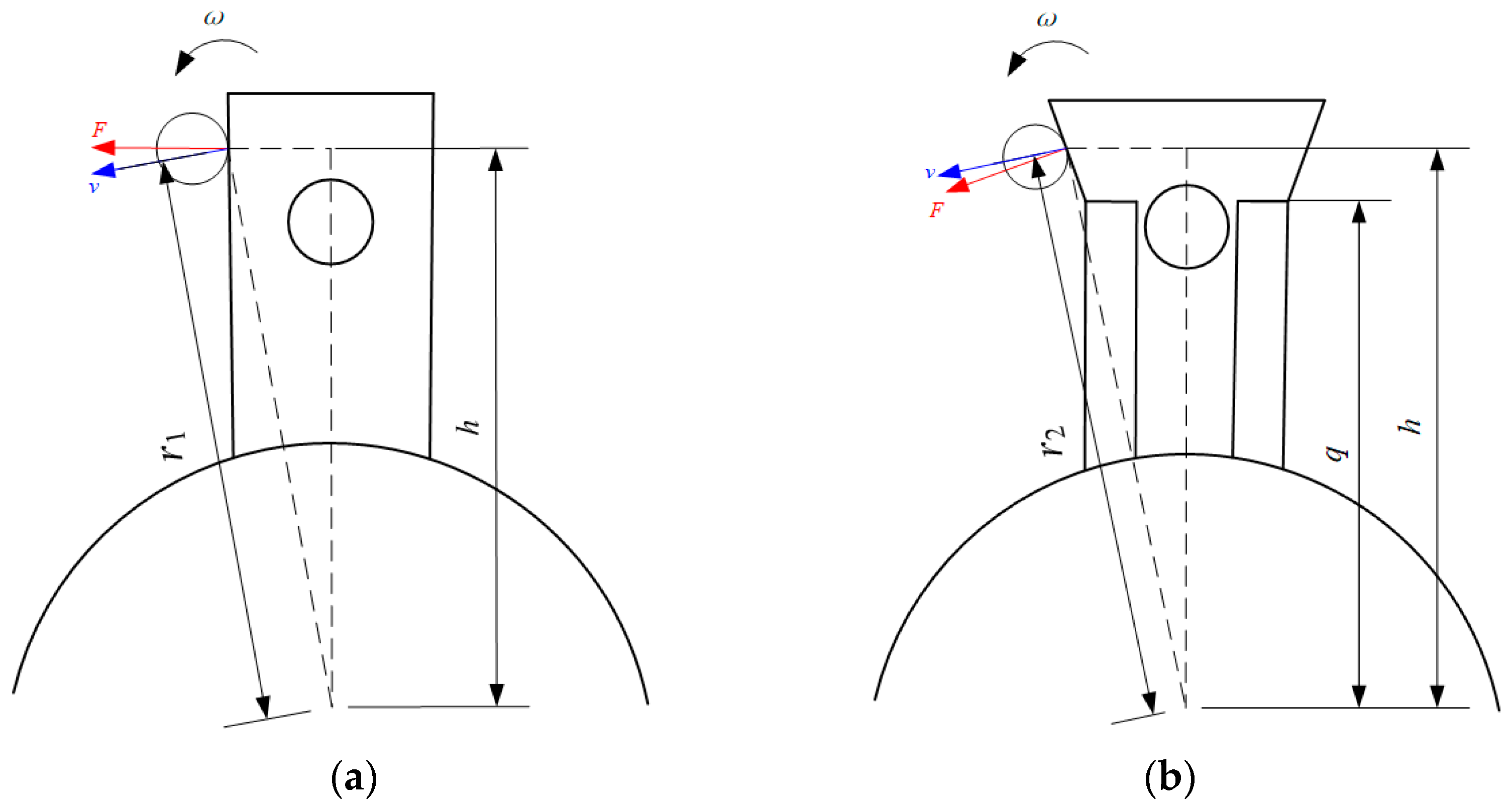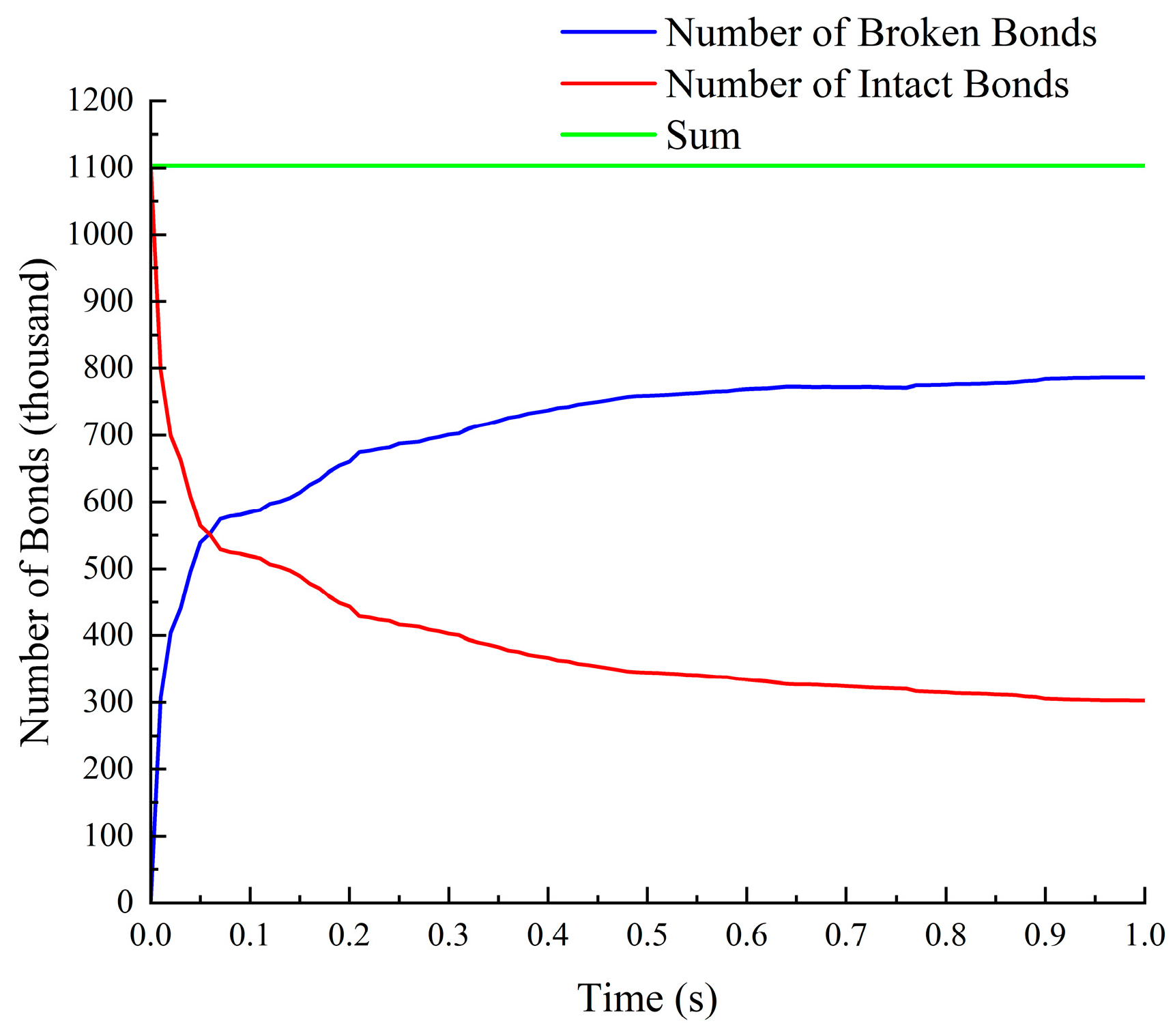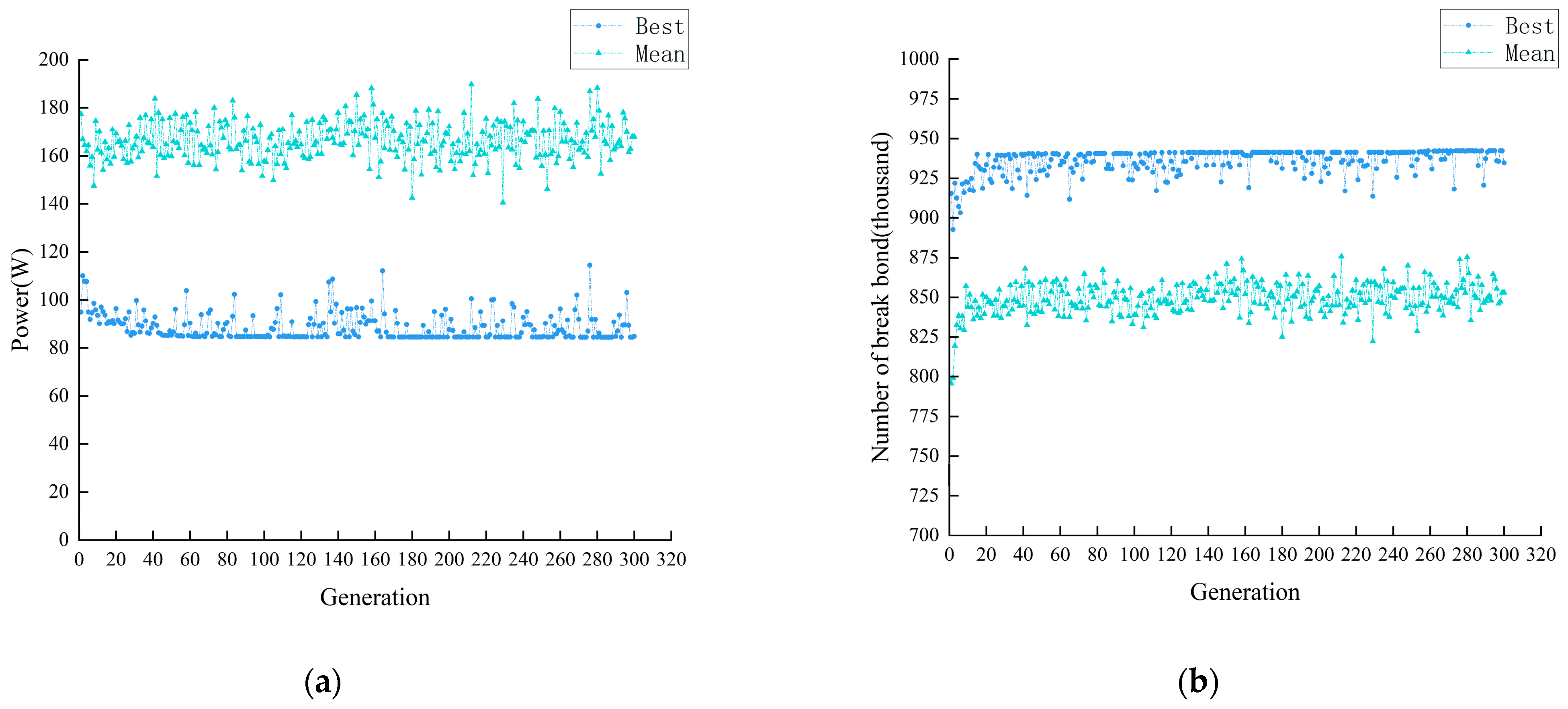Analysis and Structural Optimization Test on the Collision Mechanical Model of Blade Jun-Cao Grinding Hammer
Abstract
:1. Introduction
2. Materials and Methods
2.1. Design of Hammer Blade
2.2. Simulation Environment
2.3. Experimental Method
2.4. Bench Test Instrument
3. Results
3.1. Analysis on the Grinding Effect of Hammer Blade
3.2. Regression Analysis
3.3. Response Surface Analysis
3.4. Parameter Optimization
3.5. Contrast Test
4. Conclusions
Author Contributions
Funding
Institutional Review Board Statement
Data Availability Statement
Conflicts of Interest
References
- Lin, F.S.; Lin, D.G.; Lin, H.; Lin, H.W.; Lin, Z.X. Physiological and Photosynthetic Responses of Giant JUNCAO (Pennisetum giganteum) to Drought Stress. Fresenius Environ. Bull. 2017, 26, 3868–3871. [Google Scholar]
- Zhu, S.; Zhang, Q.; Yang, R.; Chen, B.; Zhang, B.; Yang, Z.; Chen, X.; Wang, X.; Du, M.; Tang, L. Typical JUNCAO Overwintering Performance and Optimized Cultivation Conditions of Pennisetum sp. in Guizhou, Southwest China. Sustainability 2022, 14, 4086. [Google Scholar] [CrossRef]
- Huang, C.; Wu, X.; Xiong, Y.; Rebeca, C.L.; Zhang, J.; Zhang, S.; Shao, E.; Hu, X.; Wang, R.; Xu, L.; et al. Conversion of Spent Juncao Substrate into Reducing Sugar Using a One-step Method. Energy Sources Part A 2020. [Google Scholar] [CrossRef]
- Eisenlauer, M.; Teipel, U. Comminution of Wood—Influence of Process Parameters. Chem. Eng. Technol. 2020, 5, 838–847. [Google Scholar] [CrossRef]
- Bochat, A.; Wesolowski, L.; Zastempowski, M. A Comparative Study of New and Traditional Designs of a Hammer Mill. Trans. ASABE 2015, 58, 585–596. [Google Scholar]
- Paraschiv, G.; Moiceanu, G.; Voicu, G.; Chitoiu, M.; Cardei, P.; Dinca, M.N.; Tudor, P. Optimization Issues of a Hammer Mill Working Process Using Statistical Modelling. Sustainability 2021, 13, 973. [Google Scholar] [CrossRef]
- Tekgüler, A. Effects of Oblong-Hole Screen and Round-Hole Screen on the Performance of Hammer Mill. Emerg. Mater. Res. 2021, 10, 128–135. [Google Scholar] [CrossRef]
- Evans, C.E.; Saensukjaroenphon, M.; Sheldon, K.H.; Paulk, C.B.; Stark, C.R. The Effect of Hammermill Screen Hole Diameter and Hammer Tip Speed on Particle Size and Flow Ability of Ground Corn. J. Anim. Sci. 2018, 96, 171–172. [Google Scholar] [CrossRef]
- Djordjevic, N.; Shi, F.N.; Morrison, R.D. Applying Discrete Element Modelling to Vertical and Horizontal Shaft Impact Crushers. Miner. Eng. 2003, 16, 983–991. [Google Scholar] [CrossRef]
- Ghodki, B.M.; Charith Kumar, K.; Goswami, T.K. Modeling Breakage and Motion of Black Pepper Seeds in Cryogenic Mill. Adv. Powder Technol. 2018, 29, 1055–1071. [Google Scholar] [CrossRef]
- Cheng, Q.; Wang, J.; Liu, K.; Chao, J.; Liu, D. Design of Rice Straw Fiber Crusher and Evaluation of Fiber Quality. Agriculture 2022, 12, 729. [Google Scholar] [CrossRef]
- Egorov, I.N.; Egorova, S.I. Effect of Electromagnetic Action on Dispersed Composition on Milling Ferromagnetic Materials in a Hammer Mill. Russ. J. Non-Ferr. Met. 2014, 55, 371–374. [Google Scholar] [CrossRef]
- Cotabarren, I.; Fernández, M.P.; Di Battista, A.; Piña, J. Modeling of Maize Breakage in Hammer Mills of Different Scales Through a Population Balance Approach. Powder Technol. 2020, 375, 433–444. [Google Scholar] [CrossRef]
- Vanarase, A.; Aslam, R.; Oka, S.; Muzzio, F. Effects of Mill Design and Process Parameters in Milling Dry Extrudates. Powder Technol. 2015, 278, 84–93. [Google Scholar] [CrossRef]
- Vukmirović, M.; Lević, J.D.; Fišteš, A.Z.; Čolović, R.R.; Brlek, T.I.; Čolović, D.S.; Djuragic, O. Influence of Grinding Method and Grinding Intensity of Corn on Mill Energy Consumption and Pellet Quality. Hem. Ind. 2016, 70, 67–72. [Google Scholar] [CrossRef]
- Wang, D.; Tian, H.; Zhang, T.; He, C.; Liu, F. DEM Simulation and Experiment of Corn Grain Grinding Process. Eng. Agric. 2021, 41, 559–566. [Google Scholar] [CrossRef]
- Xie, F.X.; Huo, H.P.; Hou, X.X.; Fu, Y.S.; Song, J. Experiment on the Bract Stripping and Crushing Device of a Corn Harvester. PLoS ONE 2022, 17, e0265814. [Google Scholar] [CrossRef] [PubMed]
- Martinov, M.L.; Veselinov, B.V.; Bojic, S.J.; Djatkov, D.M. Investigation of Maize Cobs Crushing—Preparation for Use as a Fuel. J. Therm. Sci. 2011, 1, 235–243. [Google Scholar] [CrossRef]
- Zhang, J.; Feng, B.; Guo, L.; Kong, L.Z.; Zhao, C.; Yu, X.Z.; Luo, W.J.; Kan, Z. Performance Test and Process Parameter Optimization of 9ff Type Square Bale Straw Crusher. Int. J. Agric. Biol. Eng. 2021, 3, 232–240. [Google Scholar] [CrossRef]
- Niu, K.; Yang, Q.Z.; Bai, S.H.; Zhou, L.M.; Chen, K.K.; Wang, F.Z.; Xiong, S.; Zhao, B. Simulation Analysis and Experimental Research on Silage Corn Crushing and Throwing Device. Appl. Eng. Agric. 2021, 4, 725–734. [Google Scholar] [CrossRef]
- Yancey, N.; Wright, C.T.; Westover, T.L. Optimizing hammer mill performance through screen selection and hammer design. Biofuels 2013, 4, 85–94. [Google Scholar] [CrossRef]
- Duan, G.C.; Shi, B.Q.; Gu, J. Research of Single-Particle Compression Ratio and Prediction of Crushed Products and Wear on the 6-DOF Robotic Crusher. Math. Probl. Eng. 2021, 2021, 6634272. [Google Scholar] [CrossRef]
- Endalew, A.M.; Debaer, C.; Rutten, N.; Vercammen, J.; Delele, M.A.; Ramon, H.; Nicolaï, B.M.; Verboven, P. A New Integrated CFD Modelling Approach Towards Air-assisted Orchard Spraying. Part I. Model Development and Effect of Wind Speed and Direction on Sprayer Airflow. Comput. Electron. Agric. 2010, 71, 128–136. [Google Scholar] [CrossRef]
- Zhang, J.; Feng, B.; Yu, X.Z.; Zhao, C.; Li, H.; Kan, Z. Experimental Study on the Crushing Properties of Corn Stalks in Square Bales. Processes 2022, 10, 168. [Google Scholar] [CrossRef]
- Hess, J.R.; Thompson, D.N.; Hoskinson, R.L.; Shaw, P.G.; Grant, D.R. Physical separation of straw stem components to reduce silica. In Biotechnology for Fuels and Chemicals; Davison, B.H., Lee, J.W., Finkelstein, M., McMillan, J.D., Eds.; Applied Biochemistry and Biotechnology; Humana Press: Totowa, NJ, USA, 2003; pp. 43–51. [Google Scholar]
- Bitra, V.S.P.; Womac, A.R.; Chevanan, N.; Miu, P.I.; Igathinathane, C.; Sokhansanj, S.; Smith, D.R. Direct mechanical energy measures of hammer mill comminution of switchgrass, wheat straw, and corn stover and analysis of their particle size distributions. Powder Technol. 2009, 193, 32–45. [Google Scholar] [CrossRef]
- GB/T 6971-2007; Test Method for Feed Mills. Standardization Administration of the People’s Republic of China, General Administration of Quality Supervision, Inspection and Quarantine of the People’s Republic of China: Beijing, China, 2008.












| Particle–Blade | Particle–Particle | |
|---|---|---|
| Coefficient of Restitution | 0.2 | 0.2 |
| Coefficient of Static Friction | 0.4 | 0.7 |
| Coefficient of Rolling Friction | 0.01 | 0.01 |
| Normal Stiffness per Unit Area (N/mm2) | Shear Stiffness per Unit Area (N/mm2) | Critical Normal Stress (MPa) | Critical Shear Stress (MPa) | Bonded Disk Radius (mm) |
|---|---|---|---|---|
| 9.6 | 6.8 | 8.72 | 7.5 | 0.7 |
| Level | Factor | ||
|---|---|---|---|
| Cutting Edge Length A (mm) | Cutting Edge Thickness B (mm) | Hammer Thickness C (mm) | |
| 1.68179 | 51.8179 | 3.68179 | 8.36359 |
| 1 | 45 | 3 | 7 |
| 0 | 35 | 2 | 5 |
| −1 | 25 | 1 | 3 |
| −1.68179 | 18.1821 | 0.318207 | 1.63641 |
| NO | Cutting Edge Length (mm) | Cutting Edge Thickness (mm) | Hammer Thickness (mm) | Bond Breakages Y | Power P |
|---|---|---|---|---|---|
| 1 | 35 | 2 | 1.636414 | 815,325 | 212.863 |
| 2 | 35 | 2 | 5 | 766,235 | 252.583 |
| 3 | 35 | 2 | 5 | 796,321 | 132.415 |
| 4 | 25 | 3 | 3 | 676,716 | 142.495 |
| 5 | 35 | 2 | 5 | 786,179 | 185.024 |
| 6 | 35 | 2 | 8.363586 | 742,066 | 212.831 |
| 7 | 35 | 2 | 5 | 776,444 | 91.236 |
| 8 | 35 | 0.318207 | 5 | 889,978 | 82.354 |
| 9 | 45 | 3 | 7 | 769,340 | 107.974 |
| 10 | 35 | 3.681793 | 5 | 710,325 | 134.311 |
| 11 | 45 | 1 | 3 | 956,745 | 281.102 |
| 12 | 25 | 3 | 7 | 621,773 | 110.278 |
| 13 | 35 | 2 | 5 | 783,024 | 207.455 |
| 14 | 45 | 3 | 3 | 839,703 | 134.956 |
| 15 | 18.18207 | 2 | 5 | 613,889 | 179.408 |
| 16 | 25 | 1 | 3 | 769,213 | 182.021 |
| 17 | 51.81793 | 2 | 5 | 882,481 | 181.112 |
| 18 | 25 | 1 | 7 | 733,801 | 165.231 |
| 19 | 45 | 1 | 7 | 917,241 | 172.365 |
| 20 | 35 | 2 | 5 | 796,151 | 162.354 |
| Source | Sum of Squares | df | Mean Square | F-Value | p-Value | |
|---|---|---|---|---|---|---|
| Model | 1.489 × 1011 | 9 | 1.654 × 1010 | 131.21 | <0.0001 | significant |
| A—Cutting edge length | 9.404 × 1010 | 1 | 9.404 × 1010 | 745.95 | <0.0001 | |
| B—Cutting edge thickness | 4.360 × 1010 | 1 | 4.360 × 1010 | 345.83 | <0.0001 | |
| C—Hammer thickness | 7.660 × 109 | 1 | 7.660 × 109 | 60.76 | <0.0001 | |
| AB | 4.563 × 108 | 1 | 4.563 × 108 | 3.62 | 0.0863 | |
| AC | 4.759 × 107 | 1 | 4.759 × 107 | 0.3775 | 0.5527 | |
| BC | 3.174 × 108 | 1 | 3.174 × 108 | 2.52 | 0.1437 | |
| A2 | 1.586 × 109 | 1 | 1.586 × 109 | 12.58 | 0.0053 | |
| B2 | 8.957 × 108 | 1 | 8.957 × 108 | 7.11 | 0.0237 | |
| C2 | 1.279 × 106 | 1 | 1.279 × 106 | 0.0101 | 0.9218 | |
| Residual | 1.261 × 109 | 10 | 1.261 × 108 | |||
| Lack of Fit | 5.828 × 108 | 5 | 1.166 × 108 | 0.8598 | 0.5638 | not significant |
| Pure Error | 6.778 × 108 | 5 | 1.356 × 108 | |||
| Cor Total | 1.501 × 1011 | 19 |
| Source | Sum of Squares | df | Mean Square | F-Value | p-Value | |
|---|---|---|---|---|---|---|
| Model | 50,251.46 | 9 | 5583.50 | 145.46 | <0.0001 | significant |
| A—Cutting edge length | 935.29 | 1 | 935.29 | 24.37 | 0.0006 | |
| B—Cutting edge thickness | 36,094.21 | 1 | 36,094.21 | 940.30 | <0.0001 | |
| C—Hammer thickness | 61,93.76 | 1 | 6193.76 | 161.35 | <0.0001 | |
| AB | 549.94 | 1 | 549.94 | 14.33 | 0.0036 | |
| AC | 119.16 | 1 | 119.16 | 3.10 | 0.1086 | |
| BC | 142.21 | 1 | 142.21 | 3.70 | 0.0832 | |
| A2 | 4765.15 | 1 | 4765.15 | 124.14 | <0.0001 | |
| B2 | 962.57 | 1 | 962.57 | 25.08 | 0.0005 | |
| C2 | 3.38 | 1 | 3.38 | 0.0879 | 0.7729 | |
| Residual | 383.86 | 10 | 38.39 | |||
| Lack of Fit | 24.88 | 5 | 4.98 | 0.0693 | 0.9946 | not significant |
| Pure Error | 358.98 | 5 | 71.80 | |||
| Cor Total | 50,635.32 | 19 |
| NO | Cutting Edge Length A (cm) | Cutting Edge Thickness B (cm) | Hammer Thickness C (cm) | Mean Power P (W) | Bond Breakages Y |
|---|---|---|---|---|---|
| 1 | 44.82853 | 1.00095 | 3.307438 | 249.2335 | 942,207 |
| 2 | 44.64202 | 2.749034 | 6.77861 | 99.40951 | 776,673 |
| 3 | 44.78693 | 2.563106 | 6.285873 | 115.5931 | 796,607 |
| 4 | 44.77821 | 2.326065 | 3.308412 | 167.8739 | 857,209 |
| 5 | 44.61134 | 2.292815 | 6.678316 | 125.7945 | 805,974 |
| 6 | 44.77056 | 1.016407 | 5.323537 | 227.4555 | 917,816 |
| 7 | 44.60674 | 1.360267 | 4.439888 | 212.391 | 901,019 |
| 8 | 44.80452 | 1.055466 | 3.553889 | 242.8482 | 935,216 |
| 9 | 44.82853 | 1.00095 | 3.307438 | 249.2335 | 942,207 |
| 10 | 44.71996 | 1.327035 | 4.93091 | 209.0372 | 898,135 |
| 11 | 44.72309 | 2.339939 | 6.167452 | 129.6454 | 811,675 |
| 12 | 44.46905 | 2.999992 | 6.999936 | 84.47981 | 757,836 |
| 13 | 44.61393 | 1.494478 | 5.781409 | 187.9295 | 874,194 |
| 14 | 44.71191 | 2.405573 | 3.703941 | 158.9335 | 846,445 |
| 15 | 44.69724 | 2.773154 | 6.386208 | 103.6859 | 782,334 |
| 16 | 44.75528 | 1.711658 | 5.346553 | 178.142 | 865,311 |
| 17 | 44.70631 | 2.073342 | 4.74662 | 163.4733 | 849,753 |
| 18 | 44.56903 | 2.929922 | 6.876811 | 89.28089 | 764,388 |
| 19 | 44.58156 | 1.687903 | 5.727792 | 175.56 | 860,661 |
| 20 | 44.79108 | 2.53502 | 4.598853 | 140.309 | 825,753 |
| 21 | 44.66016 | 1.862043 | 4.280812 | 181.79 | 869,405 |
| 22 | 44.71035 | 1.11735 | 4.054677 | 233.3952 | 924,197 |
| NO | Operating Mass (kg) | Power Consumption (kW·h) | Output Per Kilowatt-Hour (kg·(kW·h)−1) |
|---|---|---|---|
| 1 | 19.94 | 1.1 | 18.13 |
| 2 | 17.11 | 0.9 | 19.01 |
| 3 | 18.67 | 1 | 18.67 |
| 4 | 18.72 | 1 | 18.72 |
| 5 | 19.29 | 1.1 | 17.54 |
| Mean | 18.78 | 1.02 | 18.41 |
| NO | Operating Mass (kg) | Power Consumption (kW·h) | Output Per Kilowatt-Hour (kg·(kW·h)−1) |
|---|---|---|---|
| 1 | 21.41 | 1 | 21.41 |
| 2 | 22.91 | 1.1 | 20.83 |
| 3 | 18.50 | 0.9 | 20.56 |
| 4 | 21.71 | 1 | 21.71 |
| 5 | 18.01 | 0.9 | 20.01 |
| Mean | 20.49 | 0.98 | 20.90 |
Disclaimer/Publisher’s Note: The statements, opinions and data contained in all publications are solely those of the individual author(s) and contributor(s) and not of MDPI and/or the editor(s). MDPI and/or the editor(s) disclaim responsibility for any injury to people or property resulting from any ideas, methods, instructions or products referred to in the content. |
© 2024 by the authors. Licensee MDPI, Basel, Switzerland. This article is an open access article distributed under the terms and conditions of the Creative Commons Attribution (CC BY) license (https://creativecommons.org/licenses/by/4.0/).
Share and Cite
Zheng, S.; Chen, C.; Guo, Y. Analysis and Structural Optimization Test on the Collision Mechanical Model of Blade Jun-Cao Grinding Hammer. Agriculture 2024, 14, 492. https://doi.org/10.3390/agriculture14030492
Zheng S, Chen C, Guo Y. Analysis and Structural Optimization Test on the Collision Mechanical Model of Blade Jun-Cao Grinding Hammer. Agriculture. 2024; 14(3):492. https://doi.org/10.3390/agriculture14030492
Chicago/Turabian StyleZheng, Shuhe, Chongcheng Chen, and Yuming Guo. 2024. "Analysis and Structural Optimization Test on the Collision Mechanical Model of Blade Jun-Cao Grinding Hammer" Agriculture 14, no. 3: 492. https://doi.org/10.3390/agriculture14030492




